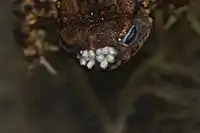Lucilia bufonivora
Lucilia bufonivora is a member of the fly family Calliphoridae which are commonly known as blow flies. L. bufonivora is commonly referred to as a toadfly. The adult flies will typically feed on pollen and nectar of flowers, while the larvae are parasitoids that feed mainly on the living flesh of the common toad (Bufo bufo), leading to the toad's death, though they have been found as parasites on other frog and toad species.[1] It is common in north west Europe.[2]
| Lucilia bufonivora | |
|---|---|
 | |
| Adult Lucilia bufonivora | |
| Scientific classification | |
| Domain: | Eukaryota |
| Kingdom: | Animalia |
| Phylum: | Arthropoda |
| Class: | Insecta |
| Order: | Diptera |
| Family: | Calliphoridae |
| Genus: | Lucilia |
| Species: | L. bufonivora |
| Binomial name | |
| Lucilia bufonivora Moniez, 1876 | |
Description
The adult toadfly has large brown compound eyes, a bright metallic green thorax and abdomen clad with bristly black hairs and a pair of membraneous, dark veined, translucent wings. The larvae are creamy white maggots similar to those of other blow flies that are found on dead animals and rotting meat.[2]
Parasitism
.jpg.webp)
The adult toadfly lays its eggs on the skin at the entrance to the nostrils of the common toad although it has been known to infest other frog and toad species.[2] It often preferentially chooses sick or injured individuals. On hatching, the larvae start to feed on the tissue of the nostrils and work their way into the nasal cavities. The larvae grow rapidly and as their appetite increases, they start to consume the eyes, the brain and other tissues of the host.

Alternatively, the eggs may be laid in wounds and eat the hosts flesh. When the toad has died and the larvae have totally consumed its tissues and finished their development, they make their way into the soil and pupate. The larvae are sensitive to temperature and only thrive between 14 °C and 29 °C. If they are cooled below this range they will stop feeding and attempt to leave the host and bury themselves shallowly in the soil to hibernate.[2]
In a study in the Netherlands, it was found that the fly selectively targeted larger toads, with no juveniles and very few one-year-olds being affected. Overall, 8% of the toads examined were hosts to the toadfly larvae and would later have died, indicating that the activities of this parasite have a significant effect on the toad population.[3]
References
- Garanin, VI; Shaldybin SL. (1976). "Parasitism of larvae of the fly, Lucilia bufonivora, Moniez, 1876, on Anura". Parazitologiia (print) (in Russian). 10 (3): 286–828.
- Séguy, E. "Un parasite des batraciens, la lucilie bufonivore: Lucilia bufonivora". Batraciens et Reptiles du Monde. Retrieved 2012-03-16.
- Strijbosch, H. (1980). "Mortality in a population of Bufo bufo resulting from the fly Lucilia bufonivora". Oecologia. 45 (2): 285–286. Bibcode:1980Oecol..45..285S. doi:10.1007/BF00346472. PMID 28309542.